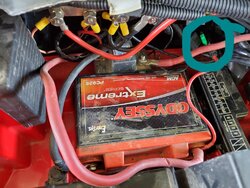Call the Warn toll free customer service number. Will only take a minute. They recommend no fuse or a simple kill switch.
A Warn 4500 pound winch pulls around 20 amps on a no load draw. And about 250 amps on a full load.
At startup you'll draw more current than you expect.
Know that fusing a winch might mean that they'll open when you're operating it. A Warn M8000 can draw as much as 400 amps at max load.
So you need to size it to tolerate your winch's max current for whatever length of time you think you'll need it to. You figure out the right type, fast acting or time delay, and rated value from their curves. A fast blow type might be specified to open at 150% of rated value in 300 seconds, so you'd have to select something in the 250A to 350A range for it not to open routinely on long pulls, for example. Hard to think you'd need to run your winch at max current for more than 5 minutes but still you need to consider that there's a tolerance to the current and time ratings.
This type of fuse might open at 10x rated value within 1/10th of a second and along the curve it will give you typical operation, so an over current of 5x might cause it to open at 1 second, etc. This is where time delay types might be considered. They are design to tolerate a large in rush for a while to accommodate things like motor starting.
For a winch this isn't really useful because the draw is sustained for minutes while a motor might take some number of second to start up before settling.
Problem with fusing is that the value you select will only really protect against cable shorts and not equipment issues. IOW, a failing solenoid could draw 200A and generate a lot of heat, causing it to become an issue and maybe catch fire without ever opening a fuse sized not to blow under normal operation. So a fuse seems to me to be incomplete protection and in a way false security if it lulls you into infrequent maintenance and inspections.
A disconnect or kill switch like would be a good option, if something does go wrong you pull the plug. So this along with a fuse to protect if a cable is cut or shorted might be the best way.
You could use something like this if you just have to have it. But, again, at lower current draws it won't save you.
Sent from my moto z4 using Tapatalk




